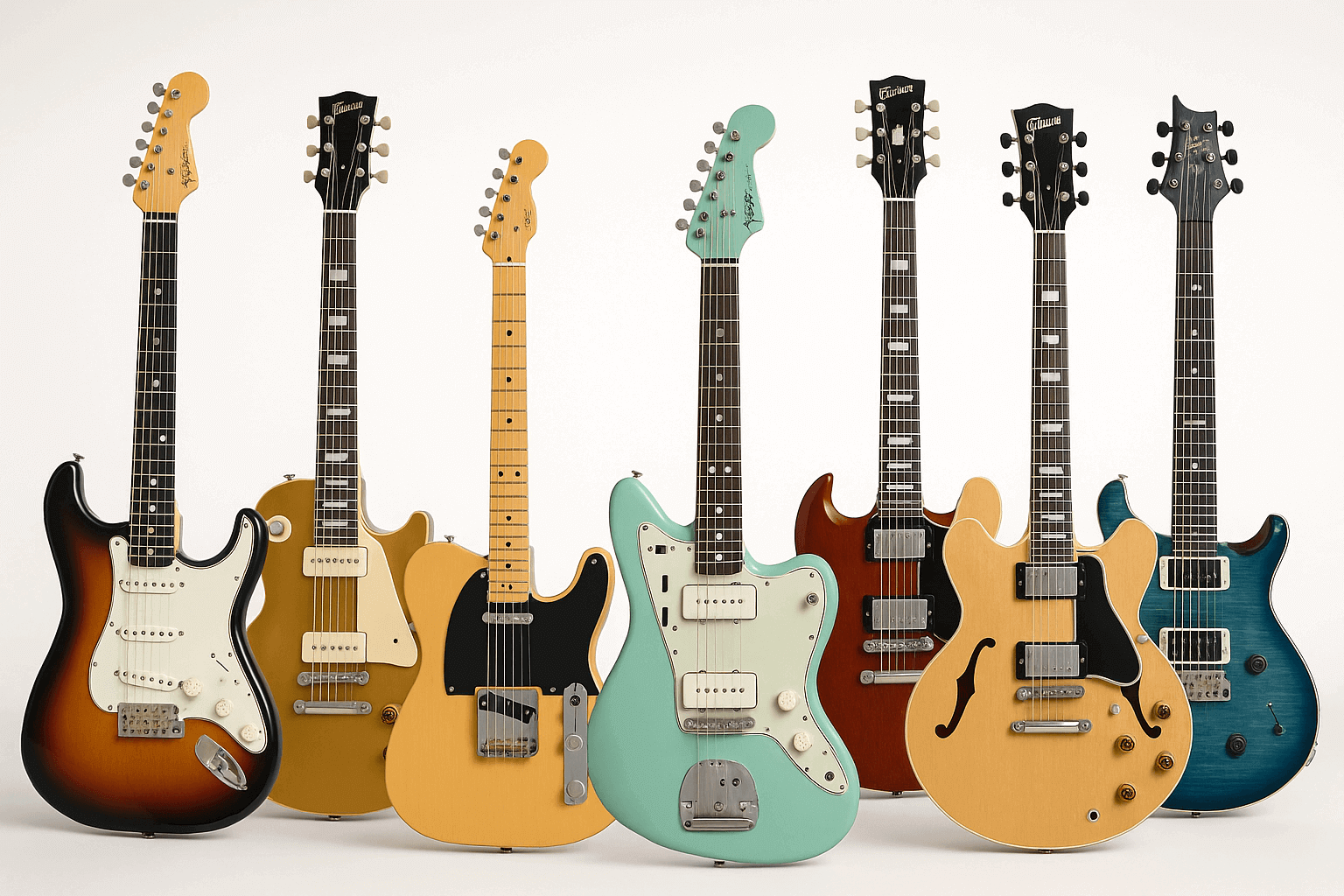Did you know that over 90 percent of iconic electric guitar players rely on just a handful of body styles to shape their sound? Choosing the right electric guitar body can make all the difference in how you play and what you create. From deep, jazz-inspired tones to biting rock riffs, the design you select opens up new musical possibilities and influences every aspect of your technique and comfort.
Table of Contents
- Solid Body Guitars: Versatility For All Styles
- Semi-Hollow Body Guitars: Rich Tone And Resonance
- Hollow Body Guitars: Classic Jazz And Blues Sounds
- Single-Cutaway Guitars: Iconic Design Benefits
- Double-Cutaway Guitars: Enhanced Playability Explained
- Extended Range Guitars: More Strings, More Options
- Signature And Boutique Guitars: Custom Features For Pros
Quick Summary
| Takeaway | Explanation |
|---|---|
| 1. Solid body guitars offer unmatched versatility. | These guitars excel in various genres, providing control over sound and excellent performance. |
| 2. Semi-hollow guitars blend warmth and feedback control. | They produce rich tones while minimizing unwanted noise, ideal for nuanced musical styles. |
| 3. Hollow body guitars are perfect for jazz and blues. | Their design enhances natural resonance, making them great for expressive playing in quieter settings. |
| 4. Single-cutaway designs enhance playability. | This style allows easier access to higher frets, benefiting complex solos and techniques. |
| 5. Extended range guitars expand harmonic possibilities. | With additional strings, they offer a larger tonal palette, suitable for advanced musical expression. |
1. Solid Body Guitars: Versatility for All Styles
Solid body electric guitars are the quintessential rock, blues, jazz and metal workhorse instrument. They represent the most versatile guitar type in a musician’s arsenal, allowing players to explore virtually every musical genre with exceptional sound quality and performance.
Unlike acoustic guitars that generate sound through their wooden body, solid body electric guitars rely completely on electromagnetic pickups and amplification. According to research from guitar experts, these guitars are constructed from a single piece of wood or multiple wood sections joined together, creating a dense instrument that eliminates acoustic resonance chambers.
Key Advantages of Solid Body Electric Guitars:
- Minimal feedback during high volume performances
- Incredible tonal range and sound manipulation
- Lightweight and comfortable playing experience
- Durability and robust construction
The design allows guitarists unprecedented control over their sound. Whether you are playing soft jazz progressions or high energy metal riffs, solid body guitars can be configured with different pickup configurations, wood types, and electronic components to deliver precisely the tone you desire.
From legendary models used by iconic musicians to modern boutique designs, solid body guitars remain the most adaptable instrument for players across skill levels and musical preferences. Professional musicians and bedroom guitarists alike appreciate their straightforward design and exceptional sonic capabilities.
When selecting your first solid body guitar, consider factors like neck profile, pickup configuration, and overall weight to ensure the instrument feels natural and inspiring in your hands.
2. Semi-Hollow Body Guitars: Rich Tone and Resonance
Semi-hollow body electric guitars represent a perfect sonic compromise between pure solid body and traditional hollow body instruments. These guitars blend warmth, resonance, and controlled feedback, making them a favourite among jazz, blues, and rock musicians seeking nuanced tonal complexity.
Unlike fully hollow guitars, semi-hollow models feature a solid wood block running through the center of the instrument. According to research on guitar construction, this design creates unique acoustic properties that deliver rich harmonic overtones while minimising unwanted feedback during high volume performances.
Key Characteristics of Semi-Hollow Body Guitars:
- Balanced sound with enhanced warmth
- Reduced feedback compared to fully hollow guitars
- Exceptional sustain and resonance
- Versatile across multiple musical genres
The semi-hollow design provides musicians with remarkable tonal flexibility. Its construction allows for greater sound manipulation compared to solid body guitars, enabling players to achieve everything from smooth jazz tones to gritty blues and rock sounds.
Musicians appreciate semi-hollow guitars for their ability to produce complex harmonics and maintain clarity at different volume levels. Whether you are performing in a small jazz club or recording in a professional studio, these instruments offer exceptional sonic depth and expressiveness.
When selecting a semi-hollow body guitar, consider factors like pickup configuration, wood type, and overall build quality to ensure you find an instrument that matches your unique playing style and musical preferences.
3. Hollow Body Guitars: Classic Jazz and Blues Sounds
Hollow body electric guitars represent the pinnacle of vintage musical expression, offering musicians a sound that breathes with organic warmth and rich harmonic complexity. These instruments are the sonic cornerstone of jazz, blues, and early rock and roll performances.
Unlike solid body guitars, hollow body models feature a completely open interior that allows sound to resonate naturally. Jazz guitarists have long celebrated these instruments for their ability to produce incredibly nuanced tones that capture the subtlety of improvisational playing.
Key Characteristics of Hollow Body Guitars:
- Warm and resonant acoustic qualities
- Exceptional clarity in lower and mid frequencies
- Superior sound reproduction for clean playing styles
- Iconic design loved by legendary musicians
The construction of hollow body guitars enables musicians to achieve sounds that blend electronic amplification with natural acoustic resonance. This unique quality makes them particularly well suited for genres that demand sophisticated tonal expression such as jazz, blues, and sophisticated rock styles.
While these guitars excel in lower volume settings, they can become challenging during high gain performances due to potential feedback issues. Professional musicians often use them in controlled environments like recording studios or intimate live performances where their extraordinary tonal qualities can be fully appreciated.
When selecting a hollow body guitar, consider factors like pickup configuration, wood type, and your specific musical genre to find an instrument that truly speaks to your artistic vision.
4. Single-Cutaway Guitars: Iconic Design Benefits
Single-cutaway guitars represent a legendary design that has shaped the sound of modern music across multiple genres. These instruments feature a distinctive body shape where one side of the guitar body is bevelled or ‘cut away’ to provide musicians with easier access to higher fretboard positions.
The history of these iconic guitars traces back to groundbreaking models that revolutionised musical performance. The cutaway design was not merely aesthetic but a functional innovation that transformed how guitarists approach their instrument.
Key Advantages of Single-Cutaway Guitars:
- Enhanced upper fretboard accessibility
- Classic aesthetic with historical significance
- Improved playing comfort and reach
- Balanced weight distribution
The single-cutaway design allows musicians to effortlessly reach higher notes on the fretboard, making complex solos and intricate playing techniques significantly more achievable. This structural modification represents a perfect blend of form and function, enabling guitarists to expand their musical expression without compromising the instrument’s structural integrity.
Musicians across rock, blues, jazz and alternative genres have embraced single-cutaway guitars for their versatility and timeless design. The aesthetic and functional benefits make these instruments a staple in professional and amateur musical setups alike.
When selecting a single-cutaway guitar, consider factors like wood type, pickup configuration, and how the instrument feels when you play it. The right guitar should feel like a natural extension of your musical creativity.
5. Double-Cutaway Guitars: Enhanced Playability Explained
Double-cutaway guitars represent a pinnacle of design innovation in electric guitar engineering. These instruments feature symmetrical indentations on both sides of the guitar body, providing musicians with unprecedented access to the entire fretboard and transforming playing techniques across multiple musical genres.
Guitar design has evolved dramatically to create instruments that are not just beautiful but supremely functional. The double-cutaway design allows players to reach notes higher up the neck with extraordinary ease and comfort.
Key Advantages of Double-Cutaway Guitars:
- Unrestricted access to upper fretboard positions
- Balanced weight distribution
- Improved ergonomics for complex playing techniques
- Sleek modern aesthetic
The dual cutaway design eliminates the traditional limitations of guitar body construction. By removing material from both sides of the instrument, manufacturers have created a playing experience that feels more intuitive and responsive. Professional and amateur musicians alike appreciate how this design reduces physical strain during extended playing sessions.
Musicians across rock, jazz, blues and experimental genres have embraced double-cutaway guitars for their versatility and technical advantages. The design allows for complex solos, intricate chord voicings and seamless transitions between different playing styles.
When selecting a double-cutaway guitar, consider factors like wood quality, pickup configuration and how the instrument feels when you play. The right guitar should feel like a natural extension of your musical creativity.
6. Extended Range Guitars: More Strings, More Options
Extended range guitars represent a revolutionary approach to musical expression, offering musicians unprecedented sonic possibilities beyond traditional six-string instruments. These guitars typically feature seven or eight strings, dramatically expanding the tonal landscape for adventurous players.
Expert musicians understand the nuanced benefits of additional strings, which provide greater harmonic complexity and lower register options. The extra strings are usually tuned to extend the guitar’s range downward, typically adding a low B or even a low A string.
Key Advantages of Extended Range Guitars:
- Expanded harmonic possibilities
- Enhanced lower frequency range
- Greater melodic and rhythmic flexibility
- Ideal for complex musical genres
Primarily popularised by metal and progressive rock musicians, extended range guitars have now found popularity across multiple genres including jazz, experimental, and contemporary classical music. The additional strings allow musicians to play bass register notes without changing instrument, creating a more integrated sound.
For players considering an extended range guitar, it is crucial to understand that these instruments require a different playing technique. The wider neck and additional strings demand more finger strength and precise fretting skills. Some guitarists find the transition challenging but ultimately rewarding.
When selecting an extended range guitar, consider factors like neck width, string spacing, and your specific musical goals. The right instrument should feel comfortable and inspire your musical creativity.
7. Signature and Boutique Guitars: Custom Features for Pros
Signature and boutique guitars represent the pinnacle of musical craftsmanship, offering musicians instruments that transcend standard manufacturing and deliver extraordinary personalised performance. These guitars are meticulously designed to meet the exacting specifications of professional musicians and passionate collectors.
Boutique guitar manufacturing represents a commitment to exceptional quality, where individual artisans create limited edition instruments with unparalleled attention to detail. Each guitar becomes a unique work of art, reflecting both the musician’s personality and the luthier’s extraordinary skill.
Key Characteristics of Signature and Boutique Guitars:
- Handcrafted with premium materials
- Customised specifications for individual playing styles
- Limited production runs
- Superior build quality and sonic performance
Professional musicians often collaborate directly with manufacturers to develop signature models that reflect their unique tonal preferences and technical requirements. These instruments frequently incorporate innovative design elements that push the boundaries of traditional guitar construction.
The appeal of signature and boutique guitars extends beyond their exceptional sound. They represent a statement of artistic identity, allowing musicians to express themselves through an instrument that is as individual as their musical voice.
When considering a signature or boutique guitar, musicians should evaluate factors like wood selection, pickup configuration, and the reputation of the luthier. While these instruments often command premium prices, they offer an unparalleled playing experience for serious musicians.
Below is a comprehensive table summarising the key characteristics, advantages, and considerations of different types of guitars discussed in the article.
| Guitar Type | Key Features | Best For |
|---|---|---|
| Solid Body | Minimal feedback, tonal range, lightweight | Rock, blues, jazz, metal |
| Semi-Hollow Body | Balanced sound, controlled feedback, resonance | Jazz, blues, rock |
| Hollow Body | Warm acoustic qualities, clarity, vintage tones | Jazz, blues, early rock |
| Single-Cutaway | Upper fretboard access, classic design | Enhanced soloing, rock, blues |
| Double-Cutaway | Access to the entire fretboard, ergonomic | Complex techniques, rock, blues, jazz |
| Extended Range | Expanded harmonic range, more strings | Metal, jazz, experimental |
| Signature/Boutique | Custom features, premium materials | Professional performance, collectors |
Discover the Perfect Electric Guitar for Every Style at MusicStreet.co.uk
Are you searching for a solid body, semi-hollow or even an extended range guitar so you can finally achieve the sound and flexibility described in our essential guide? Many guitarists struggle to find quality instruments that match their desired playability and tone. You may worry about limited selection, uncertainty around second-hand quality or the frustration of not getting expert guidance as you invest in your next instrument. With so many guitar types discussed in the article, finding the right one can feel overwhelming, especially as your musical needs evolve.
Let MusicStreet.co.uk take the confusion out of your search. Browse our curated range of new, used and premium electric guitars all expertly checked and described so you can easily compare models from solid body legends to exclusive boutique builds. We also have a wide range of electric guitar accessories. Visit MusicStreet.co.uk for real product detail photos, current pricing and trusted advice. For extra assurance, explore our educational content like guitar guides, tuning tutorials and playing articles. Ready to get hands-on? If you are in the UK, come to our Huntingdon shop for a personal demo and guidance. Experience the difference today and start playing the guitar you have always needed.
Frequently Asked Questions
What are solid body guitars, and why should I choose one?
Solid body guitars are versatile electric guitars that produce sound through electromagnetic pickups rather than acoustic resonance. Choose a solid body guitar if you want a reliable instrument that can handle various musical styles with minimal feedback and excellent tonal control.
How do I select the right semi-hollow body guitar for my playing style?
To select a semi-hollow body guitar, consider factors like pickup configuration, wood type, and your preferred genres. Test different models to find one that offers the warm sound and nuanced tonal complexity you desire, especially for jazz, blues, or rock.
What distinguishes hollow body guitars from solid and semi-hollow designs?
Hollow body guitars feature a completely open interior structure, allowing for rich, organic warmth and acoustic resonance. If you aim for a sound suitable for jazz or blues, prioritize hollow body guitars for their clarity and nuanced tonal expression.
How can a single-cutaway guitar improve my playing experience?
A single-cutaway guitar enhances upper fretboard accessibility, making it easier to play complex solos and intricate techniques. Consider a single-cutaway design to improve your reach and comfort while playing higher notes on the fretboard.
What should I consider when choosing a double-cutaway guitar?
When choosing a double-cutaway guitar, focus on its ergonomic design and the balanced weight distribution it offers. This design allows for unrestricted access to the entire fretboard, which is essential for complex playing techniques, so ensure it feels comfortable in your hands.
What are the advantages of using an extended range guitar?
Extended range guitars, with seven or eight strings, provide greater harmonic complexity and lower frequency options. If you’re exploring challenging genres like metal or progressive rock, consider incorporating an extended range guitar to expand your tonal possibilities and musical creativity.




Share:
Complete Guide to Guitar Brands: Budget to Premium
Martin Acoustic Guitars: Complete Model Comparison Guide